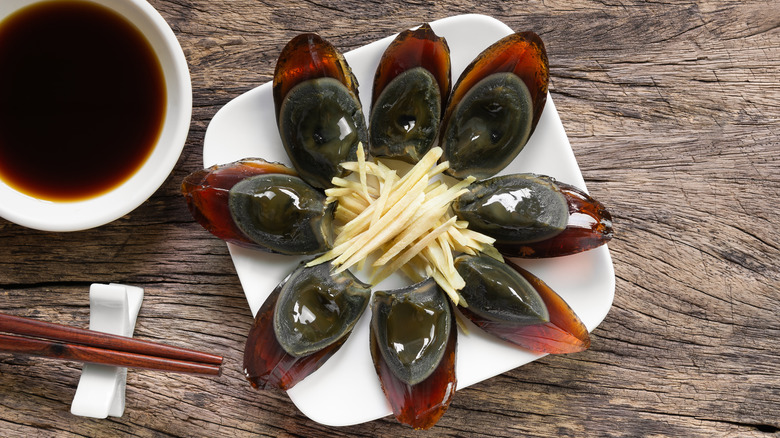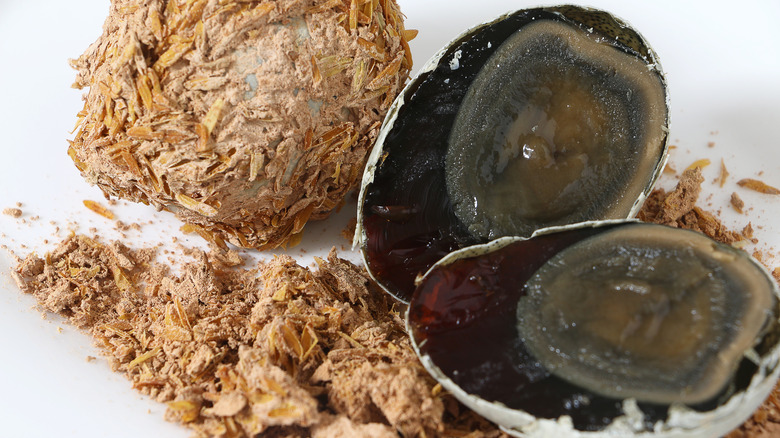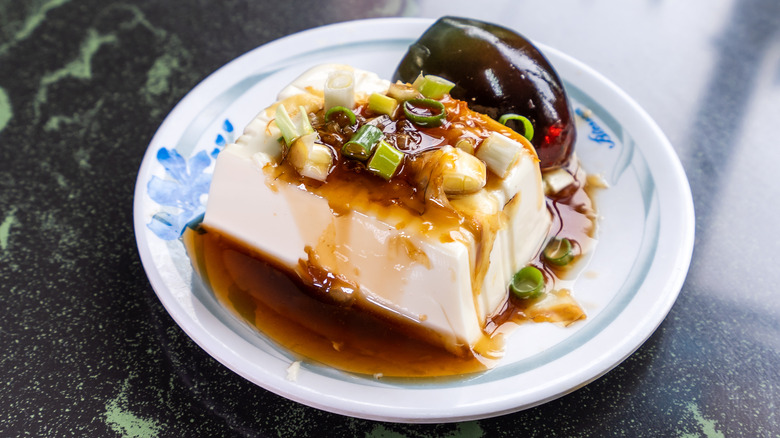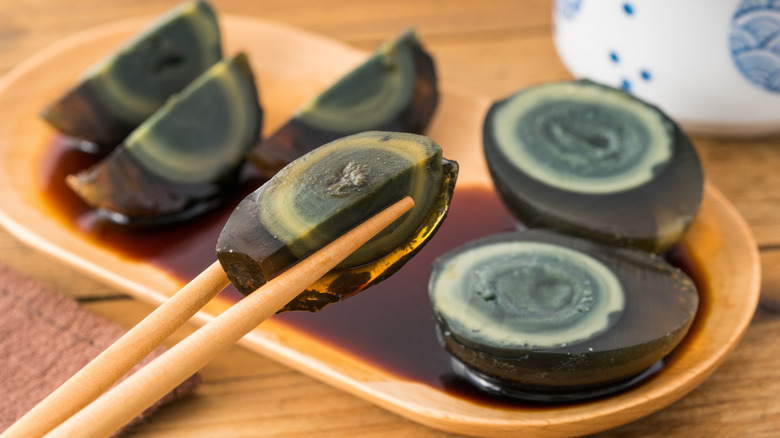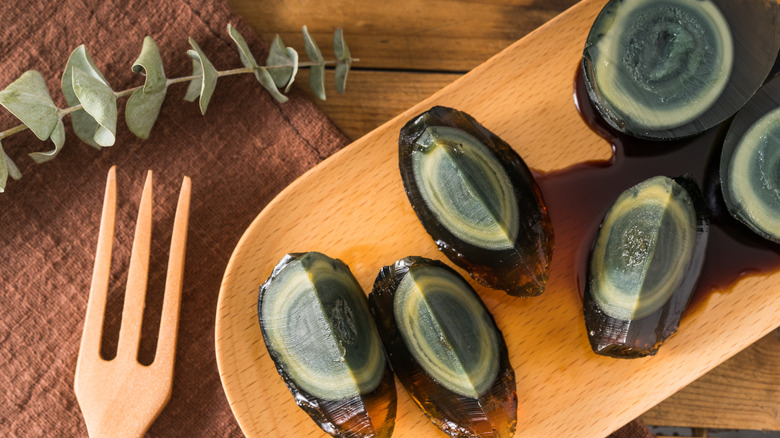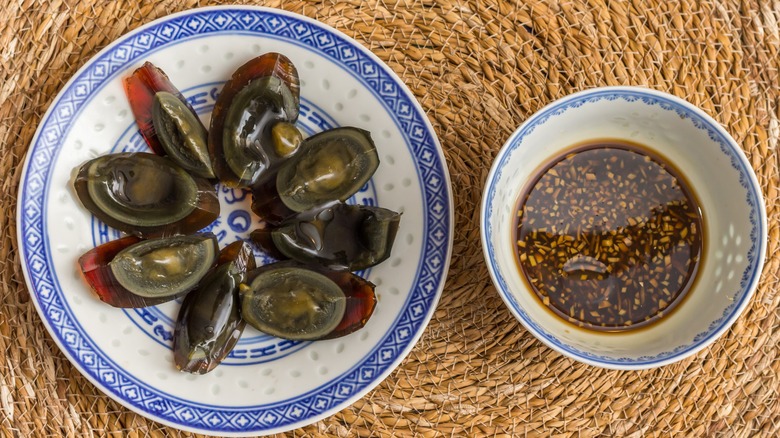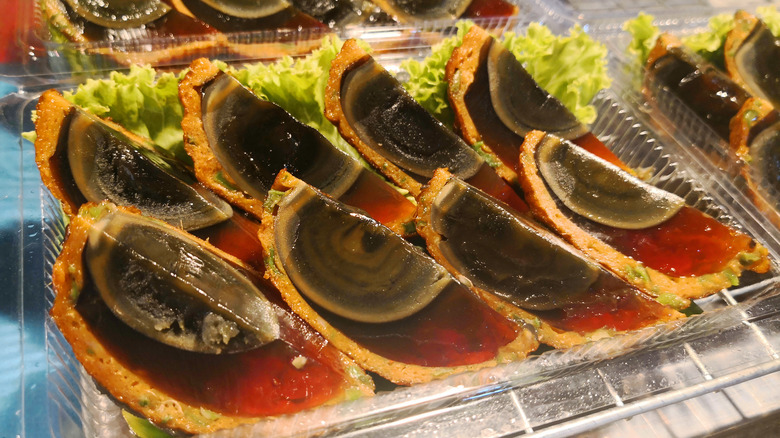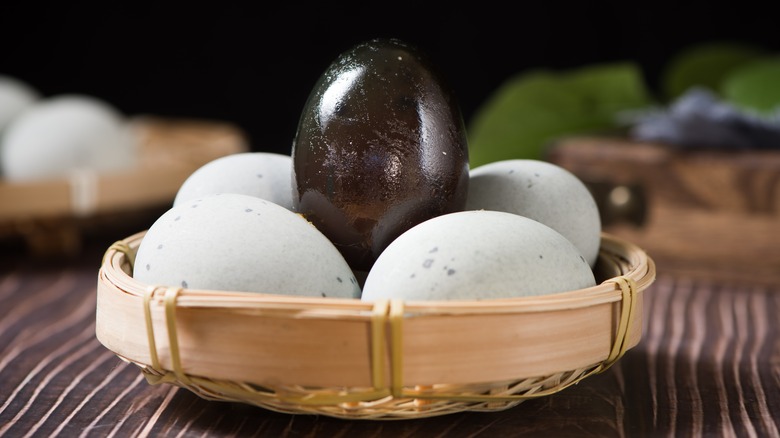What Is A Century Egg And How Should You Eat It?
You might know this distinctive ingredient as a "century egg" or "thousand-year-old egg." You might even know it by its Chinese name — "pidan" (pronounced pee-tan). No matter how you refer to it, though, you're not likely to forget a century egg if you've been served one, simply because it neither looks nor tastes like any egg you might have consumed before.
Contrary to popular folklore, century eggs don't need a hundred years — never mind a thousand — to end up looking, tasting, and smelling the way they do. Food52 says the process of turning a run-of-the-mill duck, chicken, or quail egg into a century egg takes just three months of sitting in quicklime, salt, and ash under a blanket of rice chaff to become one of the best-loved ingredients in Asian cuisine. Once they're ready to go, a peeled century egg will reveal a former egg white gone dark and gelatinous, while what was once the egg yolk is now a dark green with a squishy consistency, similar to a half hard-boiled egg. The eggs can also have a sulfuric smell, which is likely why they (undeservedly?) occupy a place in the Disgusting Food Museum.
Folklore around century eggs
Century eggs have been around a while. Travel Food Atlas says they were probably discovered during the Ming Dynasty, about 600 years ago, but legends vary as to how they were first discovered. One food origin story says they were discovered by a man who, while he was building a new home, had discovered a cache of duck eggs lying in lime for some time. Another story has them as the offering of a man who had left them in the garden of a woman he had been courting, but the eggs were not discovered until weeks later.
What is certain is that the practice of buying eggs in ash or lime was used to ensure the eggs' longevity at a time when preservation methods were limited. MasterClass says that people covered eggs in a mixture made with wood ash, salt, and calcium oxide mixed in a strong black tea, then wrapped them in rice husks while chemistry did its job and cured the eggs. While duck eggs are normally used to make century eggs, the delicacy can also be made with quail and chicken eggs. And while they might be an acquired taste, century eggs are a lively addition to any hot or cold dish they are used in.
Century egg can be served cold, mixed into a salad
Because century eggs can be consumed after their hibernation, a good number of dishes that century eggs can be found in are cold. The delicacy is traditionally enjoyed quartered and served with pickled ginger to cut through the rich flavor of the egg. Per SCMP, they are also often served up as the co-star of a chilled tofu and leek dish with a dressing made with soy sauce, ginger, garlic, sesame oil, and Japanese mirin.
But century eggs can be served hot, too. One classic way to enjoy this versatile egg is as part of the Cantonese rice porridge known as congee, when it is diced and served as a condiment, along with pork floss. Century eggs can also be cooked up into a broth with salted eggs and regular eggs, to which spinach is added for a memorable meal that's suitable for vegetarians who don't shy away from eggs. Century eggs can even be baked into a flaky pastry dessert — which challenges the trope that they're always part of a savory dish. But one truly memorable way to enjoy century eggs is when they are quartered and fried up kung-pao style with Sichuan peppercorns, chiles, and garlic, then tossed in a soy sauce-based mix, as this YouTube video demonstrates.
Century eggs can be made at home
While it might sound challenging to make your own century eggs at home, it can be done. MasterClass lists out a recipe that involves quail eggs, and which calls for black tea, kosher salt, food-grade lye, and food-grade zinc. It warns that you must be wearing protective gloves for this procedure, and that you are in a well-ventilated room. All told, the eggs can take just over a month to prepare, from start to finish.
While it is so much easier to pop to the Asian supermarket to buy century eggs, there could be a good reason to make them at home. The Disgusting Food Museum warns that there were incidents in 2013 of century egg producers in China as having used toxic chemicals and heavy metals. Today, century eggs produced in China need to met certain standards: They cannot be found with any "foreign materials" like dirt, feathers, hair, or insects; they should have a standardized weight of between 100 to 120 grams; and their shells cannot have any cracks or holes.
What do century eggs taste like?
It seems that no two people describe the flavor of century eggs the same way. This Quora thread on the subject has many responses from both century egg-lovers and haters. Some people report that century eggs have a very strong, pungent flavor. A couple of tasters compared it to funky cheese, while others noticed an iron-y edge or some bitterness. Others said that century eggs mostly just taste like eggs, perhaps with some extra richness. Respondents were just as divided about the smell of the eggs, with some noticing sulfurous or ammonia odors, while others claimed that fresh, properly made century eggs shouldn't have a smell.
The century eggs we've sampled didn't have any strong or unpleasant flavors. The whites tasted mostly like egg white and the yolks tasted mostly like raw egg yolk. The flavor was much less dramatic than you would expect based on how the eggs look. When seasoned and served as part of a complete dish, the flavor differences between regular eggs and century eggs are not that noticeable. The texture was the most unfamiliar part, with the whites being pretty gelatinous and firm and the yolks being creamy or custardy.
Where can you buy century eggs?
If you have access to an Asian grocery store, that's probably the best place to buy century eggs. Per Food52, you might find them labeled as pine flower eggs, which refers to the lovely branch-like patterns the egg exteriors sometimes develop during the curing process. (Omnivore's Cookbook also refers to them as millennium eggs or "skin egg"). Just like fresh eggs, they usually come in cartons, though it's usually just four or six eggs rather than a dozen. Red House Spice says to steer clear of century eggs with broken shells. Sometimes they're sold wrapped in the grain chaff they were cured in, but these days they're often cured in a liquid brine and sold sans grain wrapper.
You can find century eggs made with quail or chicken eggs, but most of the ones on the market are preserved duck eggs. Don't confuse them with salted duck eggs, though, which look very different and are cured in a different way (per Fine Dining Lovers). If you don't live near an Asian market, you can buy them from online sources. Amazon sells a six-pack for almost $2 per egg, but you can get them for a more reasonable price from specialty online grocers like Asian Veggies.
Nutritional information about century eggs
The nutrition facts for the century eggs sold on Amazon (which are duck eggs) show that each egg has 92 calories, 7 grams of fat (2 of which are saturated), and 8 grams of protein. That makes them a pretty good source of protein for how few calories they have. They are fairly high in sodium from the curing process, with 18% of your daily recommended sodium in each egg. Compared to the nutrition facts for a fresh duck egg listed by Self, the preserved eggs are lower in calories and fat. A single century egg does contain most of a day's worth of cholesterol, which might make them unsuitable for some people, though it's unclear whether the cholesterol in eggs is unhealthy, according to the Mayo Clinic. If you're generally healthy and you eat seven eggs a week or less, you don't have to worry.
One potential nutritional concern associated with century eggs is heavy metals. As reported by Smithsonian Magazine and ThoughtCo., some industrial manufacturers use copper sulphate or lead oxide to speed up the curing process. These additives are toxic, though you probably won't feel bad effects from them if you only eat preserved eggs occasionally. You should always check ingredient labels to make sure your eggs are free from unwanted additives.
How to store century eggs
The whole point of the curing process used to transform eggs into century eggs is to preserve them. According to Omnivore's Cookbook, unopened century eggs keep for a very long time and don't need to be refrigerated. However, storing them in the fridge can help them stay good for longer. Food52 recommends consuming century eggs within a few months of buying them if they're stored at room temperature but says they remain edible basically forever in the fridge.
This advice only applies to century eggs stored intact in their shells. Omnivore's Cookbook says you need to refrigerate opened century eggs and eat them within a couple of days. According to posters on Quora, cracked century eggs may grow mold or attract maggots if left out for too long. Additionally, century eggs may dry out if stored for excessive periods of time. If you want to eat them while they're still delicious, it's best not to store them for too long.
